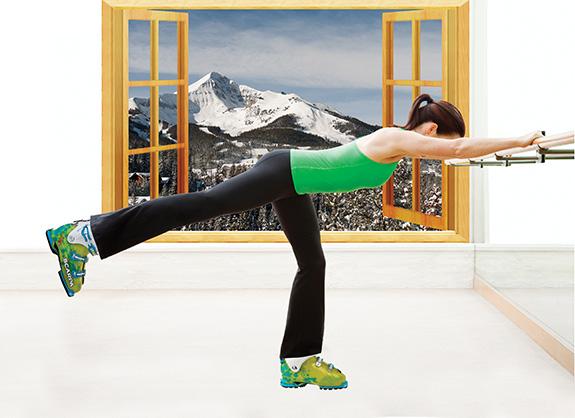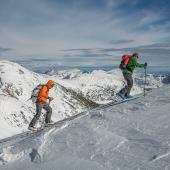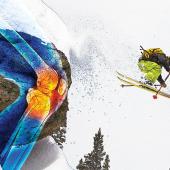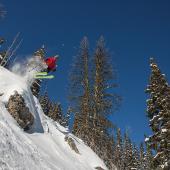Barre Hopping
The beta on barre for injury rehab.
Early into the second set of thigh work, I start shaking. Think uncontrollable sewing-machine legs and the screaming burn of a climbing forearm pump, except in the quads.
The class is lined up beside a ballet barre, each person standing on tiptoes, knees bent, backs straight. The exercise at hand involves tiny—barely discernable—pulses of our knees, with resistance bands looped around our quads. This is Pure Barre, and you’d be excused for thinking it looks easy—we’re hardly moving, after all. But you’d also be wrong.
As a former ski patroller and high-angle search-and-rescue professional, I never imagined liking barre. Wasn’t it for city girls? But with my orthopedic track record (six knee surgeries and two ankle surgeries before age 35), I’ll try anything to keep double knee replacements at bay. In 2013, my friend Colleen Tretter (a.k.a., the Green Darner, Bozeman’s gear-repair wizard) dragged me to the downtown studio.
During the initial warmup, which seemed a little like step aerobics, I giggled. But then the actual warmup began, and it was no longer funny. It was desperate. I looked over at Tretter after 15 minutes of increasingly difficult core exercises culminated in a 90-second plank and then crescendoed in pushups. She was calm, her muscles taut and defined. I was melting.
I’d found the Holy Grail: a fun, low-impact workout that makes you lean, flexible, and strong as hell. I could do it with my laundry list of injuries, and it got me fitter for outdoor sports. Plus, it only took an hour, and the music—remixes and dance music—was a total escape.
I started going once or twice a week, and soon my knees hurt less. My core got stronger, and I got lighter. Then I got pregnant, and three months in I broke my leg. Badly. Post-baby, post-ankle-surgeries, I was back at the barre. Eight months later, on day one of ski season, I skied Liberty Bowl on Big Sky’s 2,000-foot south face without stopping. I wasn’t even tired.
It’s not just me. Meg Swanson, co-owner of Spire Climbing Center, used Pure Barre to rehab her knee after a micro-fracture surgery and then pregnancy. “I was thinking about having [another] surgery, but once I started going I realized I was going to be okay,” she said.
A recent study published in the British Journal of Medicine shows results like mine and Swanson’s—where we exercised our way out of knee pain in lieu of surgery—are not uncommon.
A combination of ballet, pilates, yoga, and physical therapy, barre was invented by German-Jewish dancer Lotte Berk, who fled Nazi Germany for London in the 1930s. Initially, Berk created the workout to heal a back injury, but she eventually taught clients, including Joan Collins and Barbara Streisand. According to Berk’s 2003 obituary in The Guardian, “any woman who could not keep a 10-pence coin still on her extended thigh risked receiving a flick of the riding crop that Berk kept in the basement studio off Oxford Street… where she terrorized generations of women into shape.”
Most modern classes are a choreographed series of small, controlled exercises using bodyweight resistance. Similar to my physical therapy regimen, they involve balance, hip, and other joint mobility, with isometric holds that work both larger muscles and stabilizers. Also like PT, you can modify almost everything. Many classes use light weights, resistance bands, and exercise balls, and teach the infamous “tuck,” which is less hip thrust and more abdominal brace and engagement of the diaphragm, as if someone were punching you.
“Barre works well for people who want to increase strength and whose bodies aren’t tolerating loaded work, but they still want to gain strength and endurance,” says Amy Pakula, a physical therapist and owner of Momentum PT. “You’re working in a range of motion where you’re not having discomfort, and you’re still fatiguing the muscle to failure.”
The elephant in the room here is men, or really, the lack thereof. They rarely attend outside of the couples’ classes, which usually offer drinks afterward. In the long run I imagine barre, like yoga, will have a broader audience, because it can benefit almost anyone.
Personal trainer and Pure Barre instructor Sarah White recommends barre to all fitness levels, but she also uses it as cross-training for Spartan races. As she puts it, “It’s so hard every single time, and it gets harder as you get better at it.”
Barre Crawl
Not all barre is created equal, and each Bozeman studio has a different style (not to mention flooring surface—some are hardwood, while others are carpeted to cushion arthritic joints). All require sticky socks.
Pure Barre offers three types of classes. Classic, with its careful alignment and sharp, controlled movements; the more dynamic Empower for cardio; and a new Reform class, which is heavier on the resistance bands.
Studio Barre is on par with a Pure Barre Classic class difficulty-wise, but added “cardio snacks” make it a bit higher-energy. The studio’s vibe is fun and friendly, and the workout is fantastic.
The Bar Method offers three class types: Bar Method (classic one hour), Bar Express (45-minute power punch), and Bar Advanced (think more thigh and seat sets). Bar Method focuses on proper alignment throughout the entire class. The physical therapy-based design keeps you safe with loads of modifications for injuries, physical limitations, and pre- and post-natal. Expect lots of hands-on and verbal corrections, ensuring clients target specific muscles throughout the class.
The Ridge teaches Total Barre technique, using ballet-specific terminology and movement. The class I attended didn’t push me as hard as those above, perhaps because the style was more fluid, with bigger movements and fewer isometric holds. This would make a good class for first-timers.
Bridger Pilates focuses on individualized attention, made possible by small class sizes and Pilates instructors trained to tailor movements to each person’s injuries or imbalances. This class was mellow and lovely, warming me up nicely and with lots of active stretching and very careful strength training. I plan to bring my mom when she comes to town.









